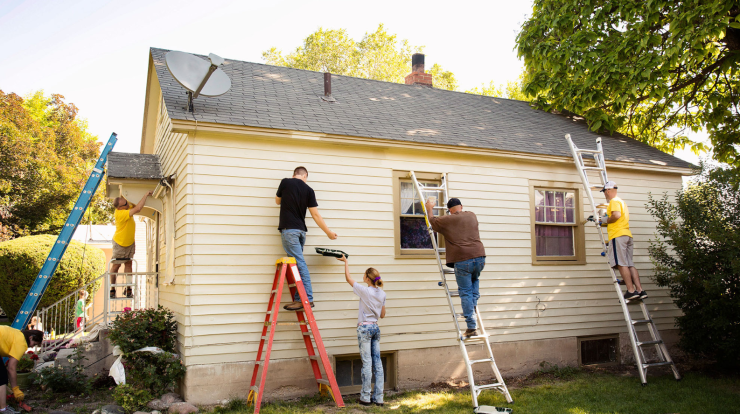How to Improve Drainage in Your Yard
Easy Yard Drainage Fixes You Can Do YourselfAs a homeowner, keeping your yard looking great is important. But what do...

Thinking about buying a home that needs a little (or a lot of) love? Fixer-uppers can be a great way to personalize your space and build equity — but they also come with challenges. In this guide, you’ll learn what defines a fixer-upper, what to watch for, and how to plan, budget, and finance your renovation journey the smart way.
A fixer-upper is a property that needs significant repairs or renovations. Whether it’s outdated design, aging systems, or structural issues, these homes require a bit of elbow grease. Buyers may choose fixer-uppers to:
• Customize a primary residence
• Flip the home for profit
• Turn it into a rental or vacation property
No matter your reason, a fixer-upper is a long-term investment that can pay off — if you plan wisely.
Pros and Cons of Buying a Fixer-Upper
✅ Pros:
• Lower Purchase Price: These homes generally cost less upfront, and that includes lower property taxes.
• Less Market Competition: Not everyone wants the hassle of renovating — giving you an edge.
• Creative Control: Design your dream kitchen, add that walk-in closet, or create an open-concept floor plan — the possibilities are yours.
• Potential ROI: Renovating the right features (think kitchens, bathrooms, or curb appeal) can greatly boost resale value.
❌ Cons:
• Renovation Costs: Materials and labor can quickly eat up your savings.
• Unexpected Repairs: Old wiring, plumbing issues, or structural surprises can be expensive and delay your timeline.
• Living in a Construction Zone: If you move in during the renovation, expect dust, noise, and some lifestyle disruptions.
Both offer personalization, but the paths are very different:
• Fixer-Uppers: Often in established neighborhoods with character and charm, possibly closer to city centers. You may live in the home while renovating.
• New Builds: Typically in newer suburban developments with modern layouts, but they cost more and take longer to construct.
Bottom line: If you have a limited budget and enjoy DIY, go with a fixer-upper. If you’re ready to invest more for a brand-new home, building might be the better choice.
To avoid a money pit, focus on three key aspects:
Seek out homes in neighborhoods with good resale potential. Look for:
• Proximity to schools, transit, shopping, etc.
• Low crime rates
• Well-maintained neighboring homes
• Local real estate trends
Find a home with a functional layout. Major structural changes — like moving load-bearing walls — are expensive. A smart layout from the start keeps your renovation costs down.
Focus on the bones. Cosmetic issues are fixable; foundation cracks or outdated electrical systems aren’t so easy (or cheap). Have a qualified inspector check everything thoroughly.
Hire a reputable inspector to identify potential red flags. Important inspections include:
• Structural assessment
• Roof condition
• Sewer and plumbing systems
• Pest and mold checks
Use directories like ASHI to find certified professionals.
💰 2. Budget Smart & Prepare for Surprises
Factor in:
• Inspection fees
• Permit costs
• Contractor bids
• DIY materials
Then add an extra 20% buffer for unexpected expenses.
📝 3. Secure the Right Financing
There are loan options tailored to fixer-upper buyers:
• Fannie Mae HomeStyle®: Good for owner-occupied or investment homes. Requires 5% down and a 620+ credit score.
• Freddie Mac CHOICERenovation®: Similar structure, renovations must be completed within 12 months.
• FHA 203(k) Loan: Low down payment (3.5%) and includes both home purchase and renovation costs.
• VA Renovation Loan: Available to qualifying veterans with $0 down, covers both purchase and improvements.
🔨 4. DIY What You Can (But Know Your Limits)
Save money by handling tasks like painting, tiling, or installing fixtures yourself — especially if you’re handy. For electrical, plumbing, or structural work, always call a licensed pro.
Need help getting started? Check out beginner DIY guides to learn skills like:
• Laying flooring
• Installing cabinets
• Fixing small plumbing issues
🗓️ 5. Create a Realistic Renovation Timeline
Break your renovation into phases:
• Immediate fixes: Foundation, roofing, or anything unsafe
• Functional areas: Bathrooms, kitchens, HVAC
• Cosmetic upgrades: Paint, trim, flooring, décor
If you plan to live in the house during renovations:
• Designate one room as a safe zone
• Set up a temporary kitchen
• Budget for hotel stays in case of major utility outages
Buying a fixer-upper can be incredibly rewarding — both personally and financially — but it’s not for everyone. Ask yourself:
• Can you handle unpredictable costs and construction delays?
• Are you comfortable living in a work-in-progress?
• Do you have the time and patience for a long-term project?
If yes, a fixer-upper could be your path to homeownership — with the bonus of creating a truly custom space.
Thinking about buying a fixer-upper? Start planning your renovation journey today. Whether you’re a first-time buyer or an experienced DIYer, with careful planning, smart budgeting, and the right professionals on your team, you can turn a worn-down property into your forever home.
great way to personalize your space and build equity — but they also come with challenges. In this guide, you’ll learn what defines a fixer-upper, what to watch for, and how to plan, budget, and finance your renovation journey the smart way.